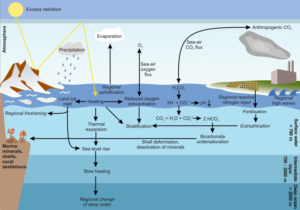Climate change and the ocean.
Relevance
GS Paper-1 Geography and its resources.
Tags: #upsc #climatechange #color of the ocean #competitiveexams.
Why in the News?
- According to a new study, the color of the Earth’s oceans has significantly altered over the past two decades, most likely due to human-induced climate change.
- Over 56 percent of the oceans, more than the total land area on the planet, have experienced a shift in color.
The impacts of the change in color of ocean.
- As per the study, the change in color of the oceans doesn’t impact marine life directly.
- However, it indicates that marine ecosystems are in a state of flux and they could completely go out of balance in the future.
- These changes could impact how productive they are and affect how much carbon the ocean stores and how much food supply there is for fisheries.
- A shift in color is happening in those regions where the oceans are getting more stratified. The stratification has increased, due to climate change, making it harder for water layers to mix with each other.
What makes the oceans colorful?
- In most regions, the oceans appear blue or navy blue due to “the absorption and scattering of light.
- When the sunlight falls on deep and clear water, colors with longer wavelengths are absorbed by the water molecules but blue and violet, which have a much shorter wavelength, are reflected back.
- But when the water isn’t deep or clean, an ocean can appear to be of a different color.
- For instance, along Argentina’s coastline, where major rivers merge into the Atlantic Ocean, the ocean exudes a brown tint because of dead leaves and sediments spewing from the rivers.
- In other parts, the oceans appear green, which happens due to the existence of phytoplankton on the upper surface of the water.
Consequences
- Oceans are able to absorb less carbon dioxide from the atmosphere.
- The oxygen absorbed isn’t able to mix properly with cooler ocean waters below, threatening the survival of marine life
- Moreover, nutrients aren’t able to travel up to the surface of the oceans from below. This directly impacts phytoplankton, which thrives, on the upper surface of the oceans.
Source: Indian Express




